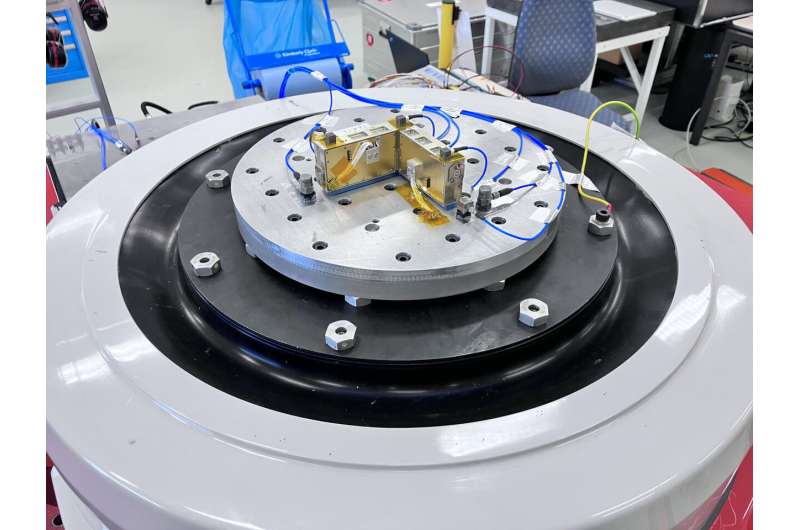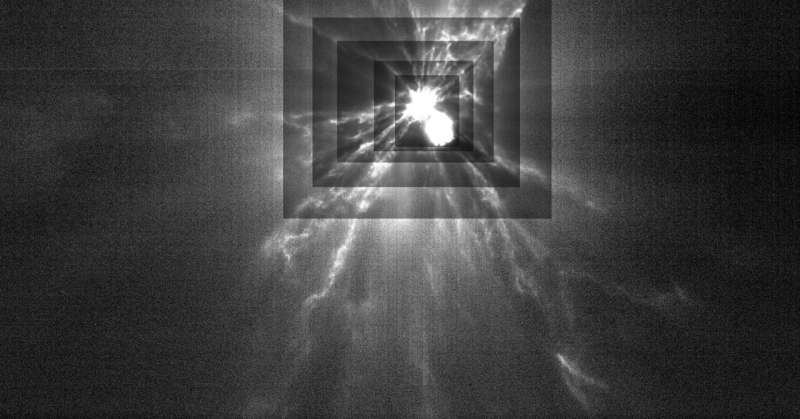GRASS gravimeter. Credit: ESA-S. Blair
The first instrument to directly measure gravity on the surface of an asteroid has undergone testing in ESA's Mechanical Systems Laboratory.
The GRASS gravimeter will be landed on the surface of the Dimorphos asteroid aboard the Juventas CubeSat—which will itself be deployed from ESA's Hera mission for planetary defense—and is designed to measure an expected gravity level of less than a millionth of Earth's own.
The Gravimeter for Small Solar System Objects, GRASS, has been developed by the Royal Observatory of Belgium (ROB) with Spain's EMXYS company.
To prove it was ready for integration with Hera's Juventas CubeSat, GRASS was subjected to spacelike vacuum and temperature extremes within a thermal vacuum chamber, then underwent sustained shaking to mimic the violence of a rocket launch.
"It may be small but GRASS is packed with complex mechanical parts and electronics," explains Jose Carrasco, overseeing the instruments at EMXYS. "We're very happy with its endurance during the test campaign. We will now follow up with a full integrity test to ensure it has sustained no damage during the testing, after which it will be passed to the GomSpace company in Luxembourg for integration aboard Juventas."
The L-shaped instrument, the size of two smartphones stuck together, is designed to measure miniscule gravity levels because the Dimorphos asteroid it will touch down on is the smallest planetary object ever to be visited by a spacecraft. At around 160 m in diameter it is about the same size as Egypt's Great Pyramid of Giza.
This image from ASI’s LICIACube show the plumes of ejecta streaming from the Dimorphos asteroid after NASA’s Double Asteroid Redirect Test, or DART, mission, made impact with it on 26 September 2022. Each rectangle represents a different level of contrast in order to better see fine structure in the plumes. By studying these streams of material, we will be able to learn more about the asteroid and the impact process. Credit: ASI/NASA/APL
Dimorphos became famous last year when it was impacted by NASA's DART spacecraft, sending out plumes of debris thousands of kilometers across space and measurably shifting its orbit around the larger Didymos asteroid.
"ESA's Hera mission is Europe's contribution to an international experiment in planetary defense," explains Hera system engineer Hannah Goldberg. "Following the DART impact, Hera will gather close-up data on the Dimorphos asteroid to turn this kinetic impact experiment into a well-understood and in principle repeatable method of planetary defense. GRASS's surface gravity measurements will help researchers learn the precise mass of the asteroid, along with radio science experiments performed by the main Hera spacecraft."
The GRASS gravimeter design involves two sets of thin blades which are anchored within cradles, both of which are continuously rotating. The slightest motion of each blade changes the overall voltage of the blade itself and its surrounding walls. This capacitance-based measuring technique gives the gravimeter a sensitivity equivalent of a single micrometer—or thousandth of a millimeter.
Özgür Karatekin of ROB adds, "Obviously the real-world performance of the gravimeter cannot be demonstrated directly here on Earth, but our lab testing coupled with numerical simulations showed we have achieved sufficiently high sensitivity to detect such low gravity."
The GRASS team also had to design an instrument small enough to fit into the Juventas CubeSat, itself only the size of a shoebox, along with Juventas' main radar instrument. In the event their final design is just 330 grams in mass and requires only half a watt of power.
Jose Carrasco notes, "The Royal Observatory of Belgium contributed the mechanical design, including the two blades, cradles and rotating motors, while EMXYS had to put together sufficiently compact electronics to operate the instrument, including copious use of commercial off the shelf parts."
Credit: ESA/Science Office
GRASS will be turned on as Juventas gradually falls to the surface of Dimorphos following the conclusion of its subsurface radar imaging campaign. The gravimeter will record the impact on the asteroid, any subsequent bounces and then any shifts in surface gravity over time, due to the influence of its parent Didymos asteroid.
Özgür Karatekin explains, "We have to assume that Juventas could land at any angle on Dimorphos, so that potentially its solar arrays will be blocked from generating any further power. Instead GRASS will run on Juventas's internal battery for up to 20 hours.
"In addition, because the instrument's two gravimeters are positioned at right angles from each other, and go on rotating, the instrument can construct the 3D gravity vector and monitor its variations from any landing position."
Once integrated within Juventas, GRASS will subsequently be tested as part of the overall nanosatellite.
Based at ESA's ESTEC technical center in the Netherlands, the Mechanical Systems Lab is equipped for environmental testing of instruments, subsystems or entire small spacecraft. It is one of a suite of about 35 ESTEC labs, tasked with investigating every aspect of the space environment.
Provided by European Space Agency

























